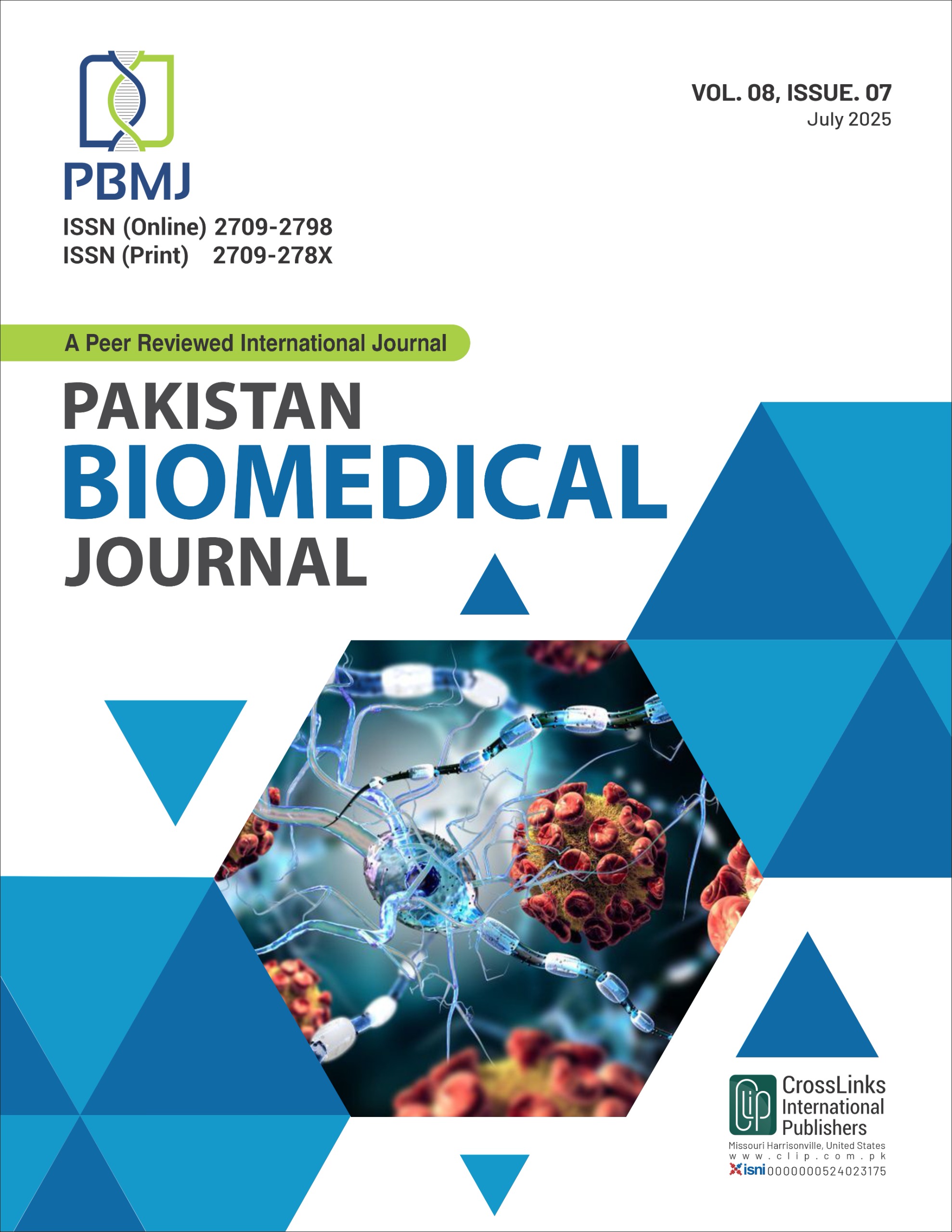Comparison of Upper Limb Weakness among Drivers and Non-Drivers
Upper Limb Weakness among Drivers and Non-Drivers
DOI:
https://doi.org/10.54393/pbmj.v8i7.1268Keywords:
Upper Extremity, Muscle Strength, Automobile Driving, Occupational Health, Range of Motion, Hand Strength, Comparative StudyAbstract
The strength of the upper limbs is crucial for performing daily activities, and prolonged working hours, such as driving, can lead to muscle weakness. Muscle activity may be impacted by repetitive movements of the upper limb, posture, and vibrations to which the drivers are exposed. The evaluation of upper limb weakness in groups of drivers and non-drivers can be used to gain insight into the occupational effects of this condition and possible preventive measures. Objective: To compare upper limb weakness among drivers and non-drivers. Methods: This comparative cross-sectional study was conducted on 54 male respondents (27 drivers and 27 non-drivers) who were recruited by a convenience sampling method. MMT was applied to evaluate the upper limb strength. SPSS version 27.0 was used to analyze data. Results: A total of 54 participants were included, evenly divided between drivers (n=27) and non-drivers (n=27). The majority were middle-aged, with the largest proportion aged 46–55 years (29.6%), and most participants were right-handed (79.6%). There were no statistically significant differences in upper limb muscle strength between drivers and non-drivers across shoulder, elbow, and wrist movements (p>0.05). However, shoulder adduction showed a notable trend, with 48.1% of non-drivers exhibiting normal strength (Grade 5) compared to only 14.8% of drivers (p=0.054). Elbow flexion also favoured non-drivers (40.7% vs. 29.6% with Grade 5 strength), though the difference was not significant (p=0.378). Most strength grades across all movements fell within Grade 4 (against some resistance) for both groups. Conclusion: It was concluded that there were significant differences in upper limb strength between drivers and non-drivers.
References
Guerreiro MM. Upper Limb Musculoskeletal Symptoms in Assembly Line Workers (Doctoral dissertation, Universidade NOVA de Lisboa (Portugal)). 2021.
Emkani M, Hashemi Nejad N, Jalilian H, Gholami M, Sadeghi N, Rahimimoghadam S. Exposure to Whole Body Vibration in Heavy Mine Vehicle Drivers and Its Association with Upper Limbs Musculoskeletal Disorders. Journal of Occupational Health and Epidemiology. 2016 Oct; 5(4): 226-34. doi: 10.18869/acadpub.johe.5.4.226. DOI: https://doi.org/10.18869/acadpub.johe.5.4.226
Vaishya R, Misra A, Vaish A, Ursino N, D’Ambrosi R. Hand Grip Strength as A Proposed New Vital Sign of Health: A Narrative Review of Evidences. Journal of Health, Population and Nutrition. 2024 Jan; 43(1): 7. doi: 10.1186/s41043-024-00500-y. DOI: https://doi.org/10.1186/s41043-024-00500-y
Lee SY. Handgrip Strength: An Irreplaceable Indicator of Muscle Function. Annals of Rehabilitation Medicine. 2021 Jun; 45(3): 167-9. doi: 10.5535/arm.21106. DOI: https://doi.org/10.5535/arm.21106
Sh T, Haghighat F, Piroozi S, Karimi A, Khanali Nejad D. The Survey and Comparison of Musculoskeletal Disorders of Shoulder, Arm and Hand in Taxi and Bus Drivers in the City of Shiraz in 2016. Archives of Rehabilitation. 2018; 19(1): 64-75. doi: 10.21859/jrehab.19.1.64. DOI: https://doi.org/10.21859/jrehab.19.1.64
Ahmadi Asour A, Mehri F, Fasih-Ramandi F, Karimi A. Prevalence of Musculoskeletal Disorders in Iranian Truck Drivers and Its Association with Road Accidents. Journal of Occupational Health and Epidemiology. 2022 Apr; 11(2): 106-13. doi: 10.52547/johe.11.2.106. DOI: https://doi.org/10.52547/johe.11.2.106
Roman-Liu D and Tokarski T. Upper Limb Strength in Relation to Upper Limb Posture. International Journal of Industrial Ergonomics. 2005 Jan; 35(1): 19-31. doi: 10.1016/j.ergon.2004.07.002. DOI: https://doi.org/10.1016/j.ergon.2004.07.002
Mungai G. Physiological Conditioning in Motorsports Athletes: A Systematic Review. 2025.
Glenn TL, Mabry JE, Hickman JS. A Catalog of Health and Wellness Programs for Commercial Drivers. 2022.
Van Harlinger W, Blalock L, Merritt JL. Upper Limb Strength: Study Providing Normative Data for A Clinical Handheld Dynamometer. Physical Medicine and Rehabilitation. 2015 Feb; 7(2): 135-40. doi: 10.1016/j.pmrj.2014.09.007. DOI: https://doi.org/10.1016/j.pmrj.2014.09.007
Stinchcombe A, Hopper S, Mullen N, Bedard M. Canadian Older Adults’ Perceptions of Transitioning from Driver to Non-Driver. Occupational Therapy in Health Care. 2024 Jan; 38(1): 110-30. doi: 10.1080/07380577.2021.1936338. DOI: https://doi.org/10.1080/07380577.2021.1936338
Unsworth C, Dickerson A, Gélinas I, Harries P, Margot-Cattin I, Mazer B et al. Linking People and Activities Through Community Mobility: An International Comparison of the Mobility Patterns of Older Drivers and Non-Drivers. Ageing &and Society. 2022 Aug; 42(8): 1938-63. doi: 10.1017/S0144686X20001968. DOI: https://doi.org/10.1017/S0144686X20001968
Chae J, Yang G, Park BK, Labatia I. Muscle Weakness and Cocontraction in Upper Limb Hemiparesis: Relationship to Motor Impairment and Physical Disability. Neurorehabilitation and Neural Repair. 2002 Sep; 16(3): 241-8. doi: 10.1177/154596830201600303. DOI: https://doi.org/10.1177/154596830201600303
Tahernejad S, Makki F, Bameri A, Zangiabadi Z, Rezaei E, Marzban H. Musculoskeletal Disorders Among Truck Drivers: A Systematic Review and Meta-Analysis. BioMed Central Public Health. 2024 Nov; 24(1): 3146. doi: 10.1186/s12889-024-20611-9. DOI: https://doi.org/10.1186/s12889-024-20611-9
Altaf S, Malmir K, Mir SM, Olyaei GR, Aftab A, Rajput TA. Prevalence and Associated Risk Factors of Sarcopenia in Community-Dwelling Older Adults in Pakistan: A Cross-Sectional Study. BioMed Central Geriatrics. 2024 Jun; 24(1): 497. doi: 10.1186/s12877-024-05111-0. DOI: https://doi.org/10.1186/s12877-024-05111-0
Ali H, Husnain A, Talib L, Nosheen I, Islam B, Mahmood H. Comparison of Mirror Therapy and Task-Specific Training on Upper Limb Function in Post-Stroke Patients with Shoulder Pain. Journal of Health, Wellness, and Community Research. 2025 Apr: e102-.
Newnam S and Oxley J. A. Program in Safety Management for The Occupational Driver: Conceptual Development and Implementation Case Study. Safety Science. 2016 Apr; 84: 238-44. doi: 10.1016/j.ssci.2015.12.020. DOI: https://doi.org/10.1016/j.ssci.2015.12.020
Cronin J, Lawton T, Harris N, Kilding A, McMaster DT. A Brief Review of Handgrip Strength and Sport Performance. the Journal of Strength and Conditioning Research. 2017 Nov; 31(11): 3187-217. doi: 10.1519/JSC.0000000000002149. DOI: https://doi.org/10.1519/JSC.0000000000002149
Dhara PC, Sengupta P, De S. Hand Grip Strength of Older Persons in Relation to Body Dimensions and Nutritional Status. Journal of Indian Academy of Geriatrics. 2011 Dec.
Dhananjaya JR, Veena HC, Mamatha BS, Sudarshan CR. Comparative Study of Body Mass Index, Hand Grip Strength, and Handgrip Endurance in Healthy Individuals. National Journal of Physiology, Pharmacy and Pharmacology. 2017 Feb; 7(6): 594-.
Downloads
Published
How to Cite
Issue
Section
License
Copyright (c) 2025 Pakistan BioMedical Journal

This work is licensed under a Creative Commons Attribution 4.0 International License.
This is an open-access journal and all the published articles / items are distributed under the terms of the Creative Commons Attribution License, which permits unrestricted use, distribution, and reproduction in any medium, provided the original author and source are credited. For comments editor@pakistanbmj.com











